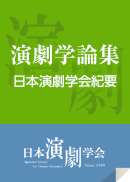37 巻
選択された号の論文の19件中1~19を表示しています
- |<
- <
- 1
- >
- >|
-
1999 年 37 巻 p. M1-M3
発行日: 1999/09/30
公開日: 2019/11/11
PDF形式でダウンロード (713K) -
1999 年 37 巻 p. M5-M8
発行日: 1999/09/30
公開日: 2019/11/11
PDF形式でダウンロード (694K)
I 演劇の理論
-
1999 年 37 巻 p. 3-18
発行日: 1999/09/30
公開日: 2019/11/11
PDF形式でダウンロード (4474K) -
1999 年 37 巻 p. 19-44
発行日: 1999/09/30
公開日: 2019/11/11
PDF形式でダウンロード (7474K) -
1999 年 37 巻 p. 45-62
発行日: 1999/09/30
公開日: 2019/11/11
PDF形式でダウンロード (5207K)
II 日本の伝統演劇
-
1999 年 37 巻 p. 65-96
発行日: 1999/09/30
公開日: 2019/11/11
PDF形式でダウンロード (9604K) -
1999 年 37 巻 p. 97-130
発行日: 1999/09/30
公開日: 2019/11/11
PDF形式でダウンロード (9841K) -
1999 年 37 巻 p. 131-154
発行日: 1999/09/30
公開日: 2019/11/11
PDF形式でダウンロード (7331K) -
1999 年 37 巻 p. 155-179
発行日: 1999/09/30
公開日: 2019/11/11
PDF形式でダウンロード (6739K) -
1999 年 37 巻 p. 181-202
発行日: 1999/09/30
公開日: 2019/11/11
PDF形式でダウンロード (6139K) -
1999 年 37 巻 p. 203-227
発行日: 1999/09/30
公開日: 2019/11/11
PDF形式でダウンロード (7068K)
III 日本の近代演劇
-
1999 年 37 巻 p. 231-280
発行日: 1999/09/30
公開日: 2019/11/11
PDF形式でダウンロード (17096K) -
1999 年 37 巻 p. 281-307
発行日: 1999/09/30
公開日: 2019/11/11
PDF形式でダウンロード (8372K) -
1999 年 37 巻 p. 309-343
発行日: 1999/09/30
公開日: 2019/11/11
PDF形式でダウンロード (9093K)
IV 西洋の演劇
-
1999 年 37 巻 p. 347-363
発行日: 1999/09/30
公開日: 2019/11/11
PDF形式でダウンロード (4529K) -
1999 年 37 巻 p. 365-383
発行日: 1999/09/30
公開日: 2019/11/11
PDF形式でダウンロード (5381K) -
1999 年 37 巻 p. 385-406
発行日: 1999/09/30
公開日: 2019/11/11
PDF形式でダウンロード (6497K) -
1999 年 37 巻 p. 407-427
発行日: 1999/09/30
公開日: 2019/11/11
PDF形式でダウンロード (6179K) -
1999 年 37 巻 p. 429-455
発行日: 1999/09/30
公開日: 2019/11/11
PDF形式でダウンロード (7696K)
- |<
- <
- 1
- >
- >|
